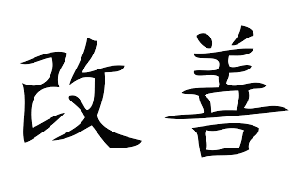Anyone who has been anywhere near a Lean consultant worth their day rate would have heard a few Japanese words thrown into the mix during client engagement spiel. Well, now you will be able to explain to them the difference between Kazian, Kaikakiu and Kakushin and stand out from your peers.
All 3 words are used in conjunction with the topics of improvement and change. More often you only hear Kazian and it often gets used in correctly as a blanket for all three words. Now-a-days you’ll hear the words during agile transformations from agile coaches or scrum masters. But like most things in agile it traditionally stems from the manufacturing sector, you’ve guessed it, in Japan.

Kaizen is the most popular word by far. Derived from the Japanese words ‘Kai‘ meaning change and ‘Zen‘ meaning good. Kaizen in the context of Lean working is all about continuous-improvement, relentless continuous-improvement. Look at your processes and ways of working and find improvements – doesn’t matter how little or trivial-seeming the improvement is, they all matter. Then continue working and repeat the process to find the next area of improvement …..no system is ever perfect.

Kaikaku, in contrast, means radical/big change. Whereas Kaizen is about small incremental improvements, Kaikaku is taking a sledgehammer to a system/process. Due to the large nature and ergo expensive nature of these changes they are normally top-down decisions. Also, Kaikaku tends to be done at a larger scale than Kaizen which is typically implemented at the team level.

Kakushin – this is the most controversial one and lean geeks will argue all day on its exact meaning. If you translate it into innovation/reform/renewal then you won’t be far wrong. Basically looking at what you are doing now and not even trying to improve it, just doing something different or radical. Kakushin follows on more from Kaikau.
Maybe the diagram below will help you visualize the differences between the 3 words and their corresponding meanings.

How you implement these 3 different things is another story which I’ll cover in future posts. As always, any comments hit me up below or drop me a tweet/insta on @pinkfatbunny

Thanks for your post I learnt a lot from it. The picture was particularly helpful. I’ve only ever heard of Kaizen before and I love the philosophy
LikeLike
Thank you, great explanation, the illustration is crystal clear, and Japanese Kanjis are good for framing the concepts.
LikeLike